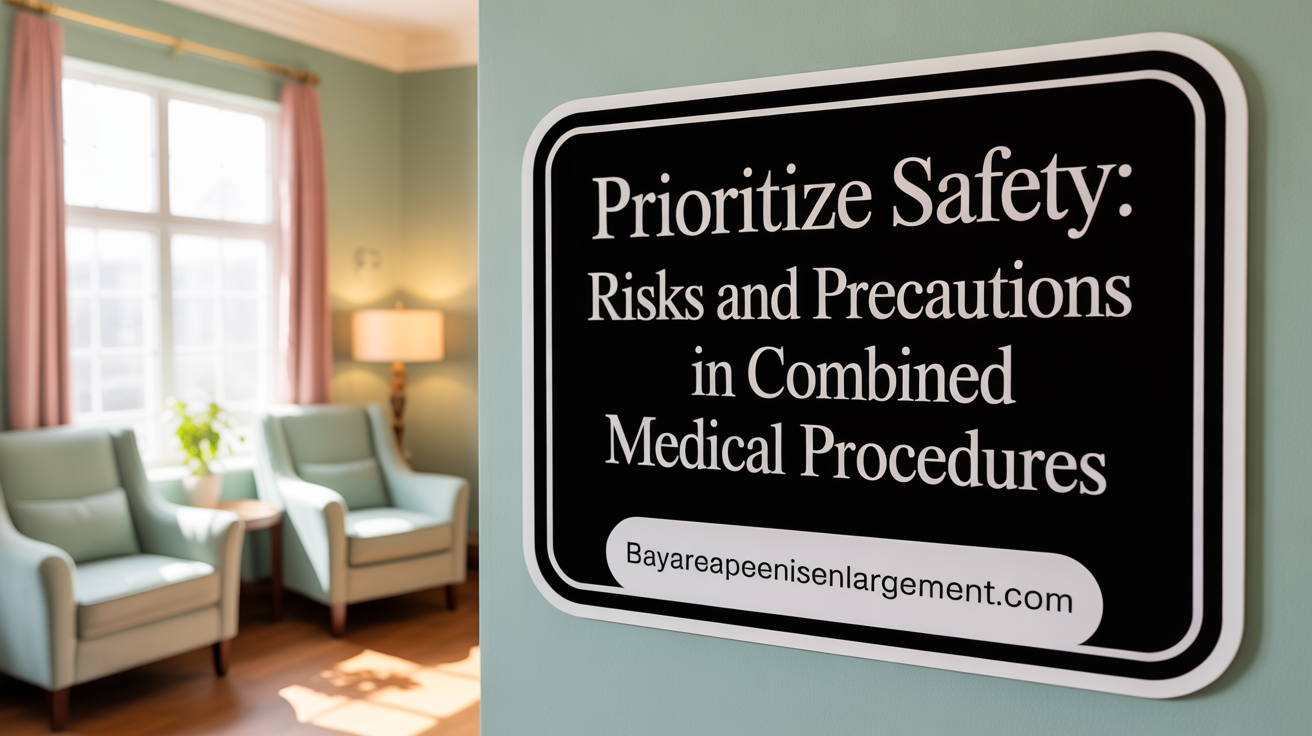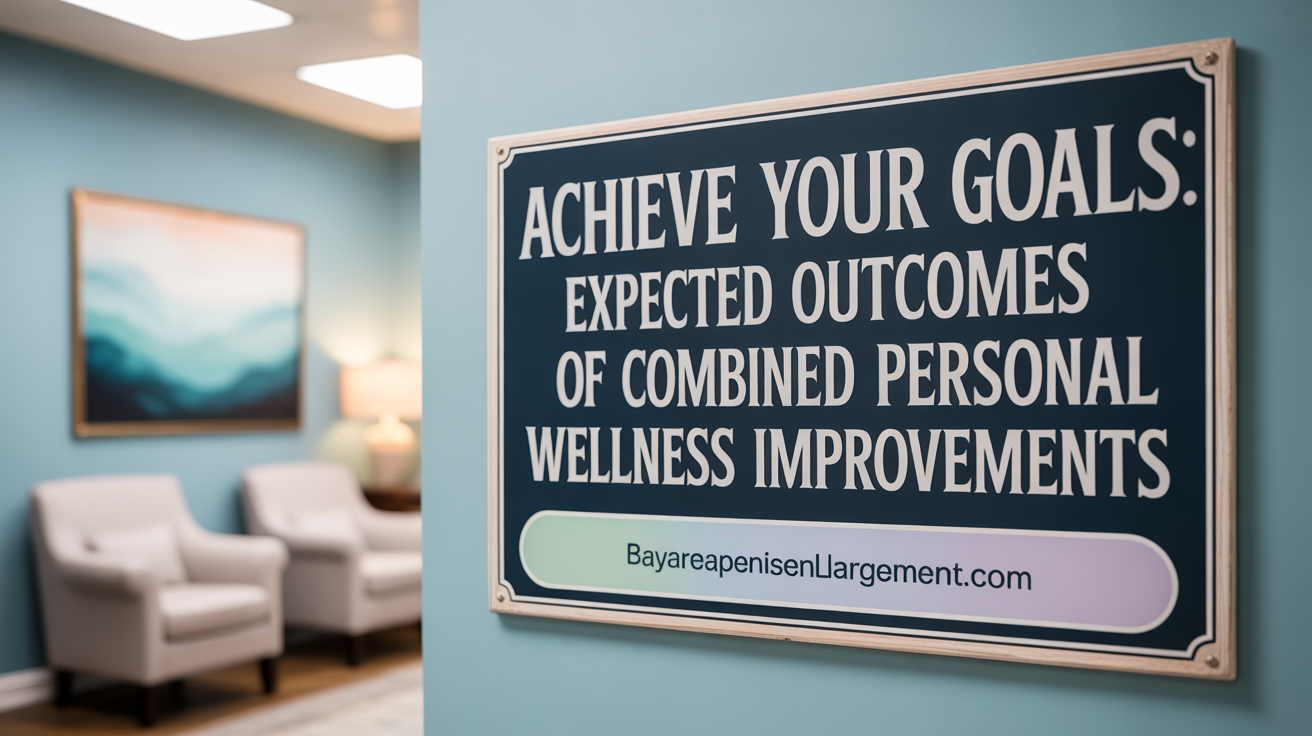Understanding Combined Penile Length and Girth Enhancement
Combining penile lengthening with girth enhancement offers men looking to improve their penile size and sexual confidence a range of innovative surgical and nonsurgical options. However, emphasizing safety, realistic expectations, and individualized treatment planning is essential to achieve effective outcomes while minimizing complications. This article explores current techniques, safety considerations, and emerging protocols that enable comprehensive and safe penile enhancement therapy.
Safe and Effective Methods for Combining Penile Lengthening and Girth Enhancement
Overview of combined procedures
Combining penile lengthening with girth enhancement offers men the opportunity to achieve a more proportionate and satisfying outcome. These procedures can be performed sequentially or during a single operative session, depending on patient preferences and the surgeon’s assessment. Lengthening techniques typically involve releasing suspensory ligaments or removing excess pubic fat, while girth can be increased through injections, grafts, or implants.
Tailored approaches based on anatomy and goals
Every patient’s anatomy, goals, and health status guide the approach to penile enhancement. A thorough evaluation includes physical measurements, imaging, and consultation to determine the most suitable techniques. Customized plans consider whether the goal is primarily length, girth, or both, and whether surgical, nonsurgical, or combined methods are optimal.
Safe surgical techniques for lengthening
For lengthening, surgeons often perform suspensory ligament release or laser ligamentolysis, which increases the visible length by allowing the penis to extend further from the pubic bone. Suprapubic lipectomy can also remove excess fat that causes a buried penis, revealing more of the penile shaft. These procedures, executed with precision by experienced surgeons, maintain the structural integrity of penile tissues and minimize complications.
Safe girth enhancement strategies
Girth can be safely increased using autologous tissue transfer such as fat injections, or tissue-engineered grafts. Hyaluronic acid fillers provide immediate volume and are reversible with hyaluronidase, with effects lasting up to two years when properly performed. Autologous fat transfer offers more permanence but carries risks such as uneven fat resorption. Emerging tissue-engineered grafts and acellular dermal matrices also promote natural tissue growth with reduced fibrosis.
Avoidance of high-risk materials
It is crucial to steer clear of foreign materials with high complication risks, such as liquid silicone or petroleum-based substances. These can cause severe adverse effects, including embolism, deformity, and irreversible damage. Proven, biocompatible options like AlloDerm, Tutoplast, or hyaluronic acid fillers are recommended, as they are supported by clinical trials demonstrating safety and efficacy.
Importance of specialist expertise and postoperative care
All procedures should be performed by experienced urologists or plastic surgeons familiar with penile surgery. Proper technique, patient selection, and meticulous postoperative care—including wound hygiene, swelling management, and activity restrictions—are essential to ensure optimal outcomes. Follow-up allows early detection and treatment of potential complications such as hematoma, infection, or fibrosis. A multidisciplinary approach, including counseling, enhances patient satisfaction while realistic expectations prevent dissatisfaction.
| Procedure Type | Methodology | Longevity | Risks & Considerations | Suitable Candidates |
|---|---|---|---|---|
| Ligament release or ligamentolysis | Surgical lengthening | Depends on technique | Neurovascular damage, scarring | Men desiring increased visible length, without penile deformity |
| Girth augmentation with fillers | Hyaluronic acid or PLLA injections | 6 months to 2 years | Swelling, granulomas, reversibility | Men seeking temporary or semi-permanent girth enhancement |
| Fat transfer | Autologous fat injection | Several years, with resorption | Nodules, uneven contour, fat atrophy | Men preferring natural tissue addition |
| Tissue-engineered grafts | Acellular dermal matrices | Long-term, tissue integration | Infection, fibrosis | Men looking for durable girth results with minimal fibrosis |
This comprehensive, personalized approach—considering safety, efficacy, and individual needs—can maximize benefits while reducing risks. Combining these techniques under expert supervision ensures functional and aesthetic satisfaction.
Surgical and Non-Surgical Options for Combined Penile Enhancement
What surgical and non-surgical options are available for combined penile length and girth enhancement?
Men seeking both length and girth improvements have various options, which can be combined for optimal outcomes.
On the surgical side, several techniques effectively increase penile size. Suspensory ligament release is commonly performed to enhance perceived length by freeing the penis from the pubic bone, resulting in an average of 1 cm to over 3 cm in length gain. Grafting procedures like augmentation corporoplasty involve grafting tissue to modulate the tunica albuginea, especially useful in Peyronie's disease or during prosthesis placement.
Girth can be increased through fat transfer, where autologous fat is injected into the penile shaft, or by using graft materials such as dermal fat grafts or acellular dermal matrices. More advanced procedures include sliding elongation techniques, V-Y or Z plasty reconstructions, and total phalloplasty, offering significant length gains.
Penile implants like the Penuma® silicone device are designed to provide permanent girth and some length enhancement, also contributing to aesthetic satisfaction.
Non-surgical methods are less invasive and generally involve injectables and regenerative therapies. Hyaluronic acid (HA) fillers, such as Revanesse Versa+ or PrimeFill™, can produce immediate girth increases of about 2 to 3.8 cm, with effects lasting approximately 18 to 30 months. These fillers are injected evenly around the shaft and can be reversed using hyaluronidase if needed.
Platelet-Rich Plasma (PRP) injections combined with vacuum devices, traction therapy, and shockwave therapy aim to stimulate tissue growth, improve elasticity, and enhance natural size over time. PRP is administered monthly and has shown promising results in increasing size and improving erectile function.
Combining these approaches allows for personalized treatment plans. For example, a patient might undergo ligament release to improve perceived length, along with fat or filler injections for girth enhancement.
Advantages and Limitations of Each Approach
| Method | Advantages | Limitations | Long-term Outcomes |
|---|---|---|---|
| Ligament release | Significant perceived length gain | Possible aesthetic changes, requires surgical skill | Permanent length change |
| Fat transfer | Natural tissue, reversibility | Variable resorption, potential lumps | Moderate girth increase, long-term variability |
| Grafting (e.g., dermal fat grafts) | Stable, customizable | Surgical risks, scarring | Long-lasting but invasive |
| Penile implants (e.g., Penuma®) | Permanent girth and some length | Surgical risks, complications, revision needed | Long-term enhancement |
| HA fillers | Immediate, reversible, minimal downtime | Temporary (up to 30 months), multiple sessions needed | Short to medium term |
| PRP and traction | Non-invasive, regenerative | Variable results, slower enlargement | Potential tissue improvement over months |
Proper combination of these techniques, tailored to individual needs and safety, can maximize results. Consulting with a specialist ensures a personalized plan that balances goals with risks.
Mechanisms and Techniques Underpinning Safe Penile Enhancement

What are the mechanisms and techniques involved in safe penile enhancement procedures?
Penile enhancement encompasses a range of methods, blending surgical, injectable, tissue engineering, and non-invasive approaches. Each technique aims to improve the size, shape, and function of the penis while ensuring safety and preserving sexual health.
Surgical modifications focus on altering the penile structure directly. For instance, suspensory ligament release involves cutting the ligament that attaches the penis to the pubic bone. This creates a perceived increase in length, typically averaging around 1 cm in flaccid state, with some motivated patients experiencing up to 3.2 cm gains. Augmentation corporoplasty uses grafts to modulate the tunica albuginea, particularly beneficial in cases like Peyronie’s disease or during penile prosthesis placement, to enhance length.
Tissue grafting options, such as autologous fat transfer and dermal fat grafts, aim to increase girth. These procedures involve injecting or grafting tissue into the penile shaft, with recent advances focusing on bioengineered scaffolds that promote tissue regeneration. Biocompatible materials like acellular dermal matrices are used to augment girth, with various studies reporting girth increases of approximately 2-3 cm, although potential complications necessitate precise surgical technique.
Injectable filler technology has gained popularity due to its minimally invasive nature. Hyaluronic acid (HA) dermal fillers, like Revanesse Versa+, are used to evenly distribute around the penile shaft, leading to immediate girth increases typically between 2.3 to 3.8 cm. These effects can last from 18 to 30 months and are reversible with hyaluronidase if needed. Other fillers, such as poly L-lactic acid (PLLA) and polymethyl methacrylate (PMMA), are also in use; PLLA stimulates collagen growth, providing durable girth gains, whereas PMMA microspheres offer more stable, long-term increases.
Tissue engineering approaches involve biodegradable scaffolds that act as frameworks for new tissue growth. Techniques using tissue-engineered scaffolds aim to stimulate natural tissue regeneration, improving girth with favorable safety profiles. Though still evolving, these methods hold promise for providing permanent and natural-looking enhancement.
Non-invasive therapies include penile traction devices and vacuum erection devices. Traction therapy, over extended periods, can modestly increase length, while vacuum devices primarily contribute to temporary girth improvements. Despite their limited effects, these methods are valued for safety and psychological benefit.
Across all techniques, safeguarding neurovascular structures and maintaining erectile function are paramount. Proper technique ensures that the dorsal nerves, arteries, and veins are preserved, preventing loss of sensation, erectile dysfunction, or deformities. Leveraging advances in imaging and surgical planning enhances safety, while rigorous infection control and patient selection optimize outcomes.
In summary, combining surgical precision, biocompatible materials, regenerative tissue engineering, and careful application of non-invasive devices allows for safe, effective penile enhancement. Ongoing research and technological innovations continue to refine these techniques, aiming for natural results with minimal risk.
Safety Considerations, Risks, and Precautions for Combined Procedures
 When performing both penile lengthening and girth enhancement in a single session, careful attention must be paid to potential complications and safety measures. Combining these procedures can amplify risks such as infections, tissue scarring, and damage to neurovascular structures due to increased surgical complexity.
When performing both penile lengthening and girth enhancement in a single session, careful attention must be paid to potential complications and safety measures. Combining these procedures can amplify risks such as infections, tissue scarring, and damage to neurovascular structures due to increased surgical complexity.
Procedures like ligament release or suprapubic lipectomy for lengthening, along with filler injections or grafting for girth, involve manipulation of delicate tissues. Using synthetic materials or grafts introduces additional risk factors, including fibrosis, deformity, and reactions to foreign bodies.
To minimize hazards, strict sterile surgical techniques and thorough patient assessment are vital. Proper patient selection ensures candidates are suitable for combined interventions and reduces the likelihood of adverse effects. Inexperienced surgeons may inadvertently increase operative risks, so experience and expertise are crucial.
Postoperative care is equally important. Close monitoring allows early detection of complications like infection, hematoma, or excessive scarring. Patients should be informed about the signs of potential issues, including pain, swelling, or deformity, and be advised about appropriate responses.
Patients need realistic counseling before surgery. Expectations should encompass potential for complications, longer recovery periods, and the possibility of needing additional procedures for optimal outcomes. Setting proper expectations helps improve patient satisfaction and adherence to postoperative guidelines.
Overall, while combining lengthening and girth enhancement can provide comprehensive aesthetic and functional improvements, these benefits come with increased safety considerations. Conducting the procedures in specialized centers by experienced surgeons and maintaining vigilant postoperative follow-up are essential to ensure safety and success.
Efficacy and Expected Outcomes of Combined Penile Enhancement Procedures

What are the expected outcomes and efficacy of combining penile lengthening and girth enhancement procedures?
Combining penile lengthening and girth enhancement techniques has shown promising results in increasing both the size and satisfaction levels among patients. Clinical studies report that such combined procedures can lead to a measurable increase in penile length—ranging from 2 to 5 centimeters—and girth enhancements of approximately 2 to 3 centimeters or more.
For girth specifically, injections of hyaluronic acid (HA) and polylactic acid (PLA) have consistently demonstrated about 20 to 23 millimeters of girth increase at around 24 weeks, with effects remaining stable over this period and no serious adverse events reported.
In addition to size gains, patients often report improvements in sexual function and confidence. For example, procedures like hyaluronic acid filler injections not only increase girth but also positively impact ejaculation latency time and Premature Ejaculation Profile scores, enhancing overall sexual satisfaction.
Long-term results tend to be durable, especially with surgical options such as autologous fat transfer and the use of biodegradable grafts, which can provide permanent enlargement with manageable risks. However, variability exists depending on patient anatomy, technique, and adherence to post-procedure care, highlighting the importance of personalized treatment plans.
Despite these encouraging findings, it is essential to recognize that many of these procedures are still considered experimental due to limited long-term data. The success of combination therapies relies heavily on the expertise of the surgeon or clinician, proper patient selection, and realistic expectations. Patients should be counseled about possible complications and the need for follow-up to maintain satisfactory outcomes.
In conclusion, when performed under appropriate conditions, combined penile lengthening and girth enhancement procedures can significantly improve size and function, contributing to higher patient satisfaction and confidence, though these benefits must be weighed against potential risks and the experimental status of some techniques.
Hyaluronic Acid Injections for Safe Penile Girth Enhancement
Are hyaluronic acid injections a safe and effective option for penile girth enhancement?
Hyaluronic acid (HA) injections have gained popularity as a minimally invasive method to enhance penile girth. Multiple clinical studies and trials have demonstrated that HA fillers can produce a mean girth increase of approximately 2.3 to 3.8 centimeters, with noticeable results visible shortly after the procedure.
These treatments are generally considered safe when performed by experienced specialists. The study conducted over three years with nearly 500 men reported that adverse events were minimal, with only a few cases of injection site infections, granulomas, and reversible reactions with hyaluronidase treatment. Serious complications such as erectile dysfunction or loss of penile sensation were not observed.
Patients typically experience immediate improvements in penile girth, lasting from six months to over two years depending on the properties of the filler used. Most reports highlight high satisfaction rates due to the natural appearance and reversibility of HA, which can be dissolved if necessary.
The technique involves even distribution of the filler around the penile shaft, performed under local anesthesia in-office, with minimal downtime. This makes it an attractive option for men seeking quick, effective results with a low risk profile.
While HA injections show promising short- to medium-term outcomes, continuous follow-up is essential to assess long-term safety and efficacy. Overall, current evidence strongly supports hyaluronic acid injections as a safe, effective, and reversible choice for penile girth enhancement, with high patient satisfaction and minimal adverse effects.
Duration and Maintenance of Nonsurgical Penile Girth Enhancements
 Nonsurgical methods for penile girth enhancement, such as dermal fillers and regenerative injections, generally offer short- to medium-term results. The longevity of these treatments can vary based on the material properties used, such as the concentration and cross-linking degree of hyaluronic acid (HA) fillers, and individual patient factors like metabolic rate.
Nonsurgical methods for penile girth enhancement, such as dermal fillers and regenerative injections, generally offer short- to medium-term results. The longevity of these treatments can vary based on the material properties used, such as the concentration and cross-linking degree of hyaluronic acid (HA) fillers, and individual patient factors like metabolic rate.
Hyaluronic acid fillers are among the most common nonsurgical options and typically produce results lasting from about 18 to 30 months. Most patients will require touch-up or maintenance sessions every 18 to 24 months to sustain the desired girth increase. These touch-ups help compensate for gradual absorption of the filler by the body.
Regenerative injections, such as Platelet-Rich Plasma (PRP) or other autologous therapies like RegeneGro, tend to stimulate natural tissue growth over a period of about six months. While initial improvements can be significant, maintaining these enhancements often involves periodic repeat treatments.
Compared to other nonsurgical approaches like vacuum devices or traction therapy, fillers and regenerative treatments provide more immediate and noticeable girth increases. However, these effects are not permanent, making ongoing maintenance essential to preserve aesthetic and functional benefits.
It is important that patients receive thorough counseling on the temporary nature of these procedures. Setting realistic expectations about the need for periodic touch-ups helps improve satisfaction and ensures proper management of the treatment process.
In conclusion, the results of nonsurgical penile girth enhancement may last for a year or more, but continued treatment is typically necessary to maintain the desired size and appearance.
Innovative Protocols and Research in Safe Penile Enhancement
Recent clinical trials and prospective studies have provided valuable insights into the evolving landscape of penile enhancement procedures. Many recent investigations focus on combining minimally invasive techniques, such as injectable fillers like hyaluronic acid (HA) and polylactic acid (PLA), with surgical and nonsurgical methods to optimize outcomes.
Emerging combination therapies integrate platelet-rich plasma (PRP), shockwave therapy, and penile traction devices to stimulate tissue growth and enhance penile size comprehensively. For example, some protocols combine PRP injections with vacuum therapy and traction devices over several months, resulting in modest but meaningful increases in length and girth, along with improved erectile function and ejaculation parameters.
Tissue engineering and scaffold development are gaining prominence as innovative solutions to improve safety and permanence. Researchers are developing biodegradable scaffolds and grafts using autologous fibroblasts or stem cells to promote natural tissue regeneration, minimizing adverse effects associated with allografts or xenografts.
Long-term safety and efficacy remain critical considerations. Current evidence suggests that fillers like HA and PLA are safe when administered properly, with transient adverse events such as swelling, granulomas, or minor infections resolving with conservative management. Surgical options like fat grafting or suspensory ligament release demonstrate lasting results, though they carry higher risks, including scar formation and deformities.
Looking ahead, future trends include the application of stem cell therapy and gene editing techniques aimed at enhancing tissue regeneration and repair at a biological level. These approaches promise to reduce complications and improve the natural aesthetics of penile enhancement. Ongoing clinical trials and technological innovations are continuously shaping a more effective, safer, and individualized approach—underscoring a move toward integrated treatments that combine safety, technical refinement, and patient satisfaction.
Postoperative Care and Managing Complications in Combined Penile Enhancements
Essential components of wound and pain management
Postoperative care begins with meticulous wound hygiene to prevent infections and promote proper healing. Patients are typically advised to keep the surgical or injection sites clean and dry, and to use prescribed topical or oral medications as directed. Pain relief is managed with non-steroidal anti-inflammatory drugs (NSAIDs) or other analgesics, depending on individual needs. Ice packs are recommended during the first 24 hours to reduce swelling and discomfort.
Monitoring for infection and inflammatory responses
Patients should be closely monitored for signs of infection, such as increased redness, swelling, warmth, pus, or a foul odor at the treatment sites. Mild inflammatory responses are common, but persistent or worsening symptoms require prompt medical attention. Regular follow-up visits enable healthcare providers to assess healing, detect early signs of complications, and intervene as necessary.
Handling complications like granulomas and priapism
Granulomas, which are small, firm nodules often resulting from filler reactions, can usually be resolved with conservative treatments or, in some cases, injections of hyaluronidase if hyaluronic acid fillers are used. Priapism, a prolonged and painful erection, is a rare but serious complication that may occur if injections or surgical procedures interfere with blood flow. Immediate medical intervention is essential to prevent long-term damage.
Importance of follow-up appointments and patient education
Follow-up care plays a vital role in ensuring successful outcomes and early detection of adverse effects. Patients should be educated on normal post-procedure changes versus signs of complications, emphasizing the importance of reporting unusual symptoms promptly. Clear instructions on activity restrictions, such as avoiding strenuous exercise and sexual activity for 1-2 weeks, help optimize healing.
Role of experienced providers in complication minimization
Procedures performed by experienced, board-certified specialists significantly reduce the risk of complications. These providers understand the anatomy intricacies and proper techniques, ensuring that interventions are safe and effective. They also tailor postoperative protocols to individual needs, enhancing patient satisfaction and outcomes.
| Aspect | Recommendations | Additional Notes |
|---|---|---|
| Wound Care | Keep dry, clean, and follow hygiene protocols | Use prescribed topical antibiotics if indicated |
| Pain Management | Use NSAIDs, cold packs, rest | Avoid NSAIDs if contraindicated due to bleeding risk |
| Infection Signs | Redness, swelling, pus, increasing pain | Seek immediate medical attention |
| Complication Handling | Granulomas: hyaluronidase; Priapism: urgent care | Early treatment prevents permanent damage |
| Follow-up | Regular visits, patient education | Reinforce activity restrictions and symptom awareness |
| Provider Role | Experience enhances safety | Proper technique and patient assessment are critical |
Psychological and Functional Benefits of Combined Penile Enhancement

Improvements in patient confidence and self-image
Many men seeking penile enhancement report increased confidence and a more positive self-image after successful procedures. Achieving even modest gains in length and girth can significantly boost self-esteem and reduce anxiety related to sexual performance.
Enhancement of erectile function and ejaculation parameters
In addition to aesthetic improvements, some studies have shown that procedures like platelet-rich plasma (PRP) injections combined with therapies such as vacuum devices and traction can improve erectile function and delay ejaculation. Patients often experience longer ejaculation latency and better overall satisfaction.
Realistic expectations for functional gains
While some treatments offer noticeable improvements, it is important for patients to have realistic expectations. Surgical and nonsurgical methods can increase length by 2-5 cm and girth by 2-3 cm, but the primary goal should be enhanced confidence and function rather than unrealistic size increases.
Inclusion of psychological support in treatment plans
Psychological counseling and support are vital components of a comprehensive approach to penile enhancement. They help manage patient expectations, address body image concerns, and support mental well-being before and after procedures.
Patient testimonials and satisfaction trends
Patient feedback frequently highlights satisfaction with improved appearance and confidence. Many report feeling more attractive and comfortable with their bodies, which positively impacts their intimate relationships. Overall, satisfaction rates remain high when procedures are performed by experienced practitioners and when expectations are well managed.
| Aspect | Typical Outcomes | Additional Notes |
|---|---|---|
| Confidence | Increased self-esteem | Psychological support enhances benefits |
| Sexual Function | Improved IELT, satisfaction | Often linked to physical changes |
| Satisfaction | High satisfaction rates | Influenced by practitioner skill |
| Expectation Management | Realistic size and function gains | Critical for positive experience |
This comprehensive view underscores how penile enhancement techniques, when integrated with psychological support, can contribute positively to both mental health and sexual function, leading to more fulfilling personal relationships.
Achieving Safe and Effective Penile Enhancement Through Integrated Strategies
The combination of penile lengthening and girth enhancement represents a promising frontier in male aesthetic and functional urology, offering tangible improvements in size, sexual function, and self-confidence. Prioritizing safety through expert assessment, tailored treatment plans, and careful selection of surgical and nonsurgical modalities is paramount. Advances in biocompatible injectable fillers, tissue engineering, and regenerative therapies continue to expand the options available, enabling customizable approaches with minimal complications. While current research underscores encouraging efficacy and satisfaction, these procedures remain largely experimental and should be approached with realistic expectations and thorough medical guidance. Ultimately, a multidisciplinary, patient-centered approach that integrates surgical precision with innovative nonsurgical techniques holds the greatest potential for achieving optimal, safe outcomes in combined penile lengthening and girth enhancement.
References
- Penile Enhancement Procedures with Simultaneous Penile ...
- Efficacy and Safety of Penile Girth Enhancement Using Hyaluronic ...
- 265 Combined Treatment of Injecting Platelet Rich Plasma With ...
- Penile Girth Enhancement - Comprehensive Urology
- (130) Increasing Penile Length and Girth in Healthy Men Using a ...
- Penis Enhancement | Full Penis Enlargement Spartacus Package
- Cosmetic penile enhancement surgery: a 3-year single-centre ...
- An Update on Penile Girth Enhancement Procedures - AUANews
- Retrospective review shows penile girth enhancement fillers induce ...

